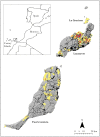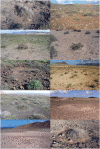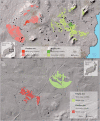Display site selection in a ground dwelling bird: the importance of viewshed
- PMID: 36998997
- PMCID: PMC10047634
- DOI: 10.1093/beheco/arac112
Display site selection in a ground dwelling bird: the importance of viewshed
Abstract
We studied the effects of visibility, female and male distribution, microhabitat and distance to human infrastructure on display site selection in a ground-dwelling bird, the Canarian houbara bustard. Using a very high-resolution digital elevation model based on LIDAR technology, and a complete census of the breeding population, we compared 98 display sites with randomly generated sites through generalized linear models. Univariate analyses showed that males displayed at locations that increased their visibility, both at short and long distances. Interestingly, although numbers of females and males around sites did not differ between display and random locations, from display locations males could see more females and males at both distance ranges. The absence of vegetation and stones was also critical as it allowed males to perform display runs on a ground free of obstacles. The amount of trophic resources did not correlate with the selection of the display site itself, though an appropriate vegetation cover seemed to be important at a wider habitat scale. Finally, display sites were farther away than random sites from sources of human disturbance, such as urban nuclei, buildings and tracks. Logistic regression analyses confirmed the importance of viewshed, low stone and vegetation cover, and distance to urban centres and tracks, and model averaging identified short-range visibility and females visible in the long range as the most important visibility variables. These results are compatible with the sexual advertisement and predator avoidance hypotheses. We provide recommendations to ensure an appropriate management of the breeding habitat of this endangered subspecies.
Keywords: Canarian houbara bustard; Chlamydotis undulata fuertaventurae; display site; microhabitat; visibility.
© The Author(s) 2022. Published by Oxford University Press on behalf of the International Society for Behavioral Ecology.
Conflict of interest statement
The authors declare that they have no known financial or personal relationships’ conflicts of interest that could have appeared to influence the work reported in this paper.
Figures



References
-
- Aben J, Pellikka P, Travis JMJ.. 2018. A call for viewshed ecology: advancing our understanding of the ecology of information through viewshed analysis. Methods Ecol Evol. 9(3):624–633.
-
- Abril-Colón I, Alonso JC, Palacín C, Álvarez-Martínez JM, Ucero A.. 2022a. Short-distance nocturnal migration in an island endemic bustard. Ibis. 164(4):1145–1159.
-
- Acosta J, Uchupi E, Muñoz A, Herranz P, Palomo C, Ballesteros M, Acosta J, Uchupi E, Muñoz A, Herranz P, et al. . 2003. Geologic evolution of the Canarian Islands of Lanzarote, Fuerteventura, Gran Canaria and La Gomera and comparison of landslides at these islands with those at Tenerife, La Palma and El Hierro. In: Geophysics of the Canary Islands. p. 1–40.
-
- Alonso JC, Álvarez-Martínez JM, Palacín C.. 2012a. Leks in ground-displaying birds: hotspots or safe places? Behav Ecol. 23(3):491–501. doi:10.1093/beheco/arr215. - DOI
LinkOut - more resources
Full Text Sources

